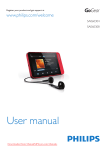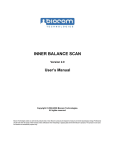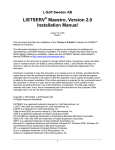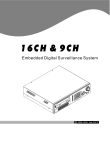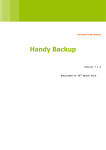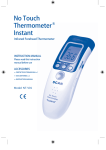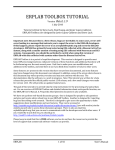Download Mindset24 Reference Manual
Transcript
Mindset24 Reference Manual , . . . Rev 1.2 Mindset24 Hardware Reference Manual Release 1.0 , i . . . Copyright and Trademark Notice Copyright © 2003 by Nolan Computer Systems, L.L.C. (NCS). All rights reserved. No part of this publication may be reproduced, stored in a retrieval system, or transmitted in any form or by any means, electronic, mechanical, photocopying, recording, or otherwise, without the prior written permission of NCS. The information contained herein is designed only for use with the Mindset24 EEG System. NCS is not responsible for any use of this information as applied to other products. Mindset is a trademark of Nolan Computer Systems, L.L.C. MS-DOS, Microsoft and Windows are trademarks (or registered trademarks) of Microsoft Corporation. Other product names used herein are for identification purposes only and may be trademarks of their respective holders. FCC Compliance Statement for Use Within the United States The Mindset24 generates and uses radio frequency energy and may cause interference to radio and television reception. It has been type tested and found to comply with the limits for a Class B computing device in accordance with the specifications for Subpart J of Part 15 of the FCC rules. These specifications provide reasonable protections against interference in a residential installation. However, there is no guarantee that interference of the Mindset24 will not occur in a particular installation. To ensure compliance of the Mindset24 to FCC rules, a shielded interface cable must be used between the Mindset24 and the computer. If the Mindset24 causes interference to radio or television reception, which can be determined by turning the Mindset24 on and off, the user can try to correct the interference by one or more of the following means: 1. Reorient the receiving antenna. 2. Reorient the Mindset24's position with respect to the receiver. 3. Plug the Mindset24 into a different power outlet so that it and the receiver are on different branch circuits. If necessary, consult the dealer or an experienced radio/television technician for additional suggestions. The user may find the following booklet helpful: “How to Identify and Resolve Radio-TV Interference Problems”. It is available from the U. S. Government Printing Office, Washington, D.C. 20402, stock number 004-000-00345-4. Printed in the United States, Revision 1.0. All information contained herein is subject to change without notice. ii DO NOT PROCEED BEFORE READING NCS assumes no liability for any direct, indirect, incidental or consequential damages resulting from the use of this product. Mindset24 is not yet FDA approved. No statement contained in this document and no information provided by Nolan Computer Systems, L.L.C. (NCS) should be construed as a claim or representation that this product is intended for use in the diagnosis, cure, mitigation, treatment or prevention of disease or any other condition. The Mindset24 hardware meets all of the FDA safety requirments for connecting such hardware to patients, including optical isolation from line voltages. Exercise extreme care in handling all connections to human subjects, including electrodes and grounding straps. Follow all guidelines provided by the manufacturer of your electrode system. If you are unsure about any connection to a human subject, stop and seek proper guidance. Mindset24 conforms to its operational and design specifications only if operated and maintained in accordance with provided instructions. Do not use this product if you suspect malfunction or observe any wear or damage. Backup all of your data before installing any new hardware, software or peripheral device. After installation, routinely backup all data. NCS is not responsible for lost or damaged data. Turn off and unplug Mindset before cleaning. See “Cleaning Mindset24” for more information. Do not spill liquid on Mindset24. Do not, under any circumstances, allow liquid to touch the input jacks or expansion connector. Do not open the Mindset24 enclosure. There are no user serviceable parts. Opening the Mindset24 enclosure will void your warranty and may expose you to hazardous electrical potentials. Do not operate the Mindset24 in any of the following circumstances: • in an ungrounded power outlet. • in a power outlet shared with heavy-load equipment such as photocopiers, air-conditioners, laser printers or large computer monitors. • if any liquid has entered the enclosure or is in close proximity to the power or interface cables. • during an electrical storm. Whenever there is lightning in the area, disconnect Mindset24’s power cable from the power outlet. • in direct sunlight or in any environment where the enclosure could become heated beyond 90˚ F. This will impair proper cooling and may cause permanent damage to Mindset24. iii How To Use This Manual This manual addresses the installation and proper use of the Mindset24. You must refer elsewhere for general EEG information and for guidance in EEG analysis. The following symbols are used to draw your attention to information that is particularly important: Critical information. Do not proceed before reading. Important advisory information. Information pertaining to electrical and electric shock issues. General advisory information. Please read all sections thoroughly before attempting to use this product. iv Table of Contents Chapter 1: Getting Started ................................................................................................................ 1 Contents of the Mindset package and system requirements. Chapter 2: Hardware Installation ...................................................................................................... 2 Configuring and connecting the Mindset24 to your computer. Configuring electrode connections. Chapter 3: Achieving Good Recordings ......................................................................................... 12 Using Mindset to obtain good EEG data. Minimizing artifact data contamination. Appendix I ...................................................................................................................................... 16 Technical support and product service information. Contacting Nolan Computer Systems, L.L.C. Appendix II ..................................................................................................................................... 18 Cleaning Mindset24. Appendix III ................................................................................................................................... 19 Mindset24 specifications. Appendix IV ................................................................................................................................... 22 Using an Electro-Cap with Mindset24. Appendix V .................................................................................................................................... 25 Additional SCSI Issues. v Chapter 1: Getting Started Contents of the Mindset Shipping Carton Your Mindset24 comes packaged in a sturdy shipping carton. If possible, retain this carton and all packing materials. If service becomes necessary, Mindset should be returned in the original carton. Inspect the carton for evidence of shipping damage or mishandling. If you discover such evidence, notify your carrier and distributor from whom you purchased Mindset. Verify that the following items are included in the carton. If any items are missing, contact the distributor from whom you purchased Mindset. 1. 2. 3. 4. 5. 6. 7. Mindset24 device 2 Linked-Ear to B Inputs Referential Montage Selectors, 19 and 24 channels (aka “Montage Selectors”) Power Supply Power Cable SCSI Terminator CD-ROM Disc containing the Mindset software Warranty Registration Card. Please register your Mindset24 so that we may keep you up-to-date about the latest product improvements, expansion options and special offers. System Requirements To use the Mindset hardware, your computer must have: 1. A Pentium class or compatible CPU. For optimum realtime performance, a 133MHz Pentium (or faster) is recommended. 2. Windows 95 or later.. 3. At least 8 megabytes of RAM. 4. At least 20 megabytes of available hard drive space. 5. At least a VGA class video adapter (an accelerated graphics adapter greatly enhances realtime neuromapping screen performance). 6. A fully Windows compliant SCSI adapter and cable. Some SCSI adapters on the market do not provide optimal performance in realtime data acquisition. For the best results, contact your distributor or refer to the enclosed document “SCSI Solutions” for a list of SCSI adapters that are known to perform well with Mindset. 1 Chapter 2: Hardware Installation Installing the Mindset24 Hardware The following illustrations identify the main features of the Mindset24 hardware. 1. Power Light 3. Circuit Reference Ground Power 1a 2a 3a 4a 5a 6a 7a 8a 9a 10a 11a 12a 13a 14a 15a 16a 17a 18a 19a 20a 21a 22a 23a 24a 1b 2b 3b 4b 5b 6b 7b 8b 9b 10b 11b 12b 13b 14b 15b 16b 17b 18b 19b 20b 21b 22b 23b 24b SCSI Reference Ground Expansion Connector Mindset24 4. EEG Input Channels 2. SCSI Sampling Light 5. Expansion Connector Figure 2.1 - Mindset Front View Feature Description 1. Power Light Indicates when the Mindset instrument is on. 2. SCSI Sampling Light Indicates when Mindset is sampling and sending data to your computer. 3. Circuit Reference Ground Used for calibration and expansion options. Not used for general EEG analysis. 4. EEG Input Channels 24 differential EEG channels marked 1- 24. “a” and “b” represent the differential inputs for each channel. 5. Expansion Connector Used to attach the included montage selectors. 2 1. Power Switch 4. SCSI Termination & ID 3. SCSI Connectors 2. DC Power Connector Figure 2.2 - Mindset Rear View Feature Description 1. Power Switch Turns Mindset off and on. 2. DC Power Connector Jack for connection to the DC power supply. Never connect any other power supply or other device to this connector. Doing so will void your warranty and may result in serious injury or equipment damage. 3. SCSI Connectors Connects Mindset to your computer and possibly to other devices in the SCSI chain. 4. SCSI Termination & ID DIP style switches used to set Mindset’s SCSI ID number and to select termination power. 3 Typical Mindset Connections Figure 2.3 illustrates typical connections between Mindset, a power source, a computer, a montage selector and an electrode system. Your specific configuration may be different. Computer with SCSI Adapter AC Outlet DC Power Supply DC Jack SCSI Cable Power 1a 2a 3a 4a 5a 6a 7a 8a 9a 10a 11a 12a 13a 14a 15a 16a 17a 18a 19a 20a 21a 22a 23a 24a 1b 2b 3b 4b 5b 6b 7b 8b 9b 10b 11b 12b 13b 14b 15b 16b 17b 18b 19b 20b 21b 22b 23b 24b SCSI Reference Ground Expansion Connector Mindset24 Montage Selector Example Cap Electrode Inputs Ear Inputs Figure 2.3 - Typical Mindset Connections 4 Connecting Mindset to Your Computer Step 1 - Position the Mindset24 Find a level, flat, solid surface on which to place your unit. Place the unit away from sources of 60 Hz electrical noise such as computer monitors, power supplies and florescent lighting to reduce the risk of 60Hz contamination in your EEG data. Step 2 - Connect the Power Cable Power off all of your computer equipment and Mindset. Turn off power to Mindset, to your computer and to all devices on the SCSI chain before making any modifications to the SCSI bus. Connect the power supply to the back of Mindset as previously illustrated. Plug the power supply’s three-prong power plug into an appropriately grounded power receptacle, preferably with surge and spike protection. Never operate Mindset in an ungrounded power outlet or in a power outlet shared with heavyload equipment such as photocopiers, fans, air-conditioners, laser printers, or large computer monitors. Step 3 - Connect the SCSI Cable Connect the SCSI cable to your computer's SCSI port. Then connect the remaining 50-pin end to the back of Mindset in either the top or bottom 50-pin connector. These two connectors are functionally identical and the open connector can be used for adding more SCSI devices or for termination (more on termination below). Mindset amplifies EEG signals up to 32,000 times, so it is very sensitive to electrical noise. One potential source of noise is your computer’s SCSI bus. SCSI adapters (particularly PCMCIA notebook SCSI adapters) and other SCSI devices may be a source of noise. Please refer to Chapter 3: Achieving Good Recordings for more details. SCSI devices are physically connected together by cables in a daisy chain. When we refer to first or last devices, we refer to the physical location of the device within the daisy chain rather than the SCSI identification number (ID) of the device. Terminator Computer Middle Device Figure 2.4 - SCSI Daisy Chain 5 Mindset24 Step 4 - SCSI Termination The SCSI interface specifications permit up to seven peripheral devices to be connected to one host device. The first and last devices on the chain must have terminating resistors installed. Terminating resistors can be implemented in many different ways. NCS has supplied a small rectangular 50 pin terminator block that plugs into one of the two 50 pin SCSI connectors on the back of Mindset. Figure 2.5 - SCSI Terminator Block In addition to termination resistors, Mindset is able to supply termination power to the SCSI bus. In most cases, Mindset’s termination power should be enabled when the termination block is installed and disabled when the termination block is not installed. When deciding if you need to install the terminator block and select Mindset’s SCSI termination power, use the following guide: Situation Mindset is the only SCSI device connected to the computer. Terminator & Termination Power ON Mindset is the second of two SCSI devices connected to the computer. ON Mindset is the last SCSI device in a chain of three or more devices. ON* Mindset is not the first or last device in a chain of three or more devices. OFF * In this case, make sure that none of the middle devices are terminated. Only the first and last devices should be terminated. Your computer may have a SCSI peripheral (e.g., hard disk drive, CD-ROM drive) device inside its case. Refer to your computer's user manual to identify if there is an integrated SCSI peripheral device. If you do have a SCSI peripheral device either inside or connected to a SCSI bus on your computer, then you must identify its SCSI ID number and determine if it is terminated. 6 Step 5 - SCSI Termination Power & ID Selection Switch Each device connected to your computer's SCSI interface must have a unique SCSI identification number. The eight possible numbers are 0 through 7. SCSI ID number 7 is usually reserved for the host, so select SCSI ID numbers 0 to 6. When you select a number for Mindset, be certain that no other SCSI device has the same SCSI ID including any internal or tabletop devices already attached to your system. Refer to the illustration and table below to set Mindset’s SCSI ID and termination power option. Use a small jeweler’s screwdriver or a straightened paper clip to change the switches. Termination Power Table 2.1 - DIP Switch Settings SCSI ID 1 2 3 4 Switches Switch 1 - Termination Power. Default position is down (off). To activate termination power, position the switch up. To set SCSI ID: 0 1 2 3 4 5 6 Mindset Rear View, Lower Left Side SCSI ID 2 Shown 7 (Do not use) Set Switch 2: up down up down up down up down Set Switch 3: up up down down up up down down Set Switch 4: up up up up down down down down Figure 2.6 - DIP Switch Location Once the switches are set correctly, you do not have to change them again unless you change your SCSI bus configuration. Mindset reads its own SCSI ID each time power is applied, so it is necessary to power Mindset off and on following a SCSI ID change. Step 6 - Power Up Mindset Ensure that you have: 1. 2. 3. 4. 5. A good location for Mindset. The Mindset off and the power cord connected. The SCSI cable is connected to both your computer's SCSI adapter and Mindset. Termination is used, if necessary. The SCSI ID is set correctly. 7 Turn on Mindset’s power. Mindset's power switch is on the rear left side of the enclosure. The red power light should come on and the yellow SCSI light should flash briefly. It is a good idea to turn on all of the external SCSI devices before switching on your computer. Step 7 - Power Up Your Computer When you boot your computer for the first time after connecting the Mindset hardware or after making any change to your SCSI adapter, you may see an “Unknown Device” dialog: This indicates that the operating system has located Mindset on the SCSI bus. In general, you should select the “Do not install a driver” option or allow Windows to search for (but not find) a driver. Select “Finish” when prompted. As Mindset does not install a SCSI device driver in your system, Windows considers it an unknown device. The above procedure instructs Windows to consider Mindset an “Other device” in your System Properties, Device Manager Tab as shown below. If Windows cannot locate the Mindset, re-check your SCSI card installation and all of the electrical connections. Make sure that you have the correct version of Wnaspi32.dll located in your system folder. Figure 2.7 - System Properties Window, Device Manager Tab 8 Electrode Configuration Mindset is designed to accommodate any electrode system that has input leads which terminate in 1.5 mm touch-proof safety connectors. If your input leads terminate in 2 mm tip plugs, adapters are available from most electrode system manufacturers and resellers who carry EEG supplies. NCS accepts no liability for hazards which might arise from improper use of your electrode system. Exercise extreme care in handling all connections to human subjects, including electrodes and grounding straps. Follow all guidelines provided by the manufacturer of your electrode system. If you are unsure about any connection to a human subject, stop and seek proper guidance. Do not attempt to defeat any safety measures which may be integral to your electrode system. Do not construe the instructions in this manual to suggest practices that may allow any part of the electrode assembly to come into contact with a source of dangerous electrical potential while a subject is connected. Connection between EEG leads and ear clip leads to Mindset is accomplished through the front panel, as shown below: 1a 2a 3a 4a 5a 6a 7a 8a 9a 10a 11a 12a 13a 14a 15a 16a 17a 18a 19a 20a 21a 22a 23a 24a 1b 2b 3b 4b 5b 6b 7b 8b 9b 10b 11b 12b 13b 14b 15b 16b 17b 18b 19b 20b 21b 22b 23b 24b Expansion Connector Figure 2.8 - Mindset24 Front Panel, Electrode Input Section All 24 Mindset EEG channel amplifiers have an “a” and “b” input. These are differential inputs. Each channel amplifies the difference between signals applied to its “a” and “b” inputs to create the final differential signal which is digitized and sent to your computer. In this way, a signal common to both inputs is rejected (e.g., ambient 60 Hz). Please consult another source for general information on EEG systems design, common-mode rejection and other general aspects of EEG signal amplification. 9 The international 10-20 standard for electrode placement is illustrated in Figure 2.9. Fp 1 Fp 2 Gnd F7 F8 Fz F3 F4 A1 A2 C3 Cz C4 T3 T4 Pz P3 P4 T5 T6 O1 O2 Figure 2.9 - International 10-20 Standard If channel 1a is connected to Fp1 and channel 1b is connected to Fp2, the signal sent to your computer on channel 1 would be the difference between Fp1 and Fp2. This is represented in EEG nomenclature as Ch 1 = Fp1-Fp2. One standard configuration (or montage) for EEG neuromapping is known as linked-ear referential. This is Mindset’s default neuromapping montage. In a linked-ear referential montage, all channels’ “b” inputs are connected to ear clip positions A1+A2. This is accomplished by connecting one of the included montage selectors to the expansion connector on the Mindset front panel. Doing so ties each channel’s “b” inputs together. By inserting the input jacks from your electrode system’s ear clip leads into any two “b” inputs, you tie every channel’s “b” input to A1+A2. If your electrode system utilizes mastoid references, simply connect the input jacks from those leads into any two “b” inputs when the montage selector is in place. If you are using an Electro-Cap with Mindset, refer to Appendix IV for additional information. 10 The default neuromapping connection between Mindset’s input channels and the 10-20 standard electrode positions is as follows: Table 2.2 - Standard 10-20 Electrode Positions Channel 1 2 3 4 5 6 7 8 9 10 11 12 13 14 15 16 17 18 19 “a” input Fp1 Fp2 F7 F3 Fz F4 F8 T3 C3 Cz C4 T4 T5 P3 Pz P4 T6 O1 O2 “b” input A1+A2 A1+A2 A1+A2 A1+A2 A1+A2 A1+A2 A1+A2 A1+A2 A1+A2 A1+A2 A1+A2 A1+A2 A1+A2 A1+A2 A1+A2 A1+A2 A1+A2 A1+A2 A1+A2 This default connection table is provided for convenience only. Mindset24 has 24 channels, so when using the 10-20 standard, 5 of Mindset’s channels are unconnected. You may chose to connect any of the 10-20 electrode positions to any Mindset input channel. If you differ from this default, however, you must instruct the Mindset software that you have done so (this is covered in the software reference manual). Mindset does not provide an accessible point to connect to earth ground. If you intend to use your electrode system’s grounding point, you have to connect this lead to earth ground. Remember to follow all guidelines provided by the manufacturer of your electrode system. If you are unsure about any connection to a human subject stop and seek proper guidance. See Chapter 3: Achieving Good Recordings for additional information on human subject earth grounding. Never connect a human subject to an earth ground unless you are absolutely certain that the connection point is at earth ground potential! If you do connect a human subject to earth ground, through whatever means, you must assure that the subject does not come in contact with any source of electrical potential. Failure to comply with these warnings can expose the human subject to harmful and even fatal electrical current! Electrode Impedance Checking The electrode impedance should be minimized in accordance with instructions provided with your specific electrode system. Use of an electrode impedance meter ensures that each electrode is making proper contact with the subject’s skin. 11 Chapter 3: Achieving Good Recordings You must refer to other sources for general EEG information, description of proper EEG recording techniques, and for detailed discussion of EEG artifacts. A general knowledge of EEG is essential to obtaining valid data. Please read the Electrode Configuration paragraphs of Chapter 2 before attempting EEG recording. Techniques to Obtain the Best EEG Recordings with Mindset Follow these steps to obtain the best EEG recordings when using Mindset: 1. Assure proper electrode impedance values for your electrode system. 2. Restrict movement of the subject while recording. Using a rolled towel to support the subject’s neck will minimize head movement. 3. Watch the maximum amplitude of the input signal. If the amplitude exceeds 120 microvolts (uV) peak-to-peak, the amplifiers will saturate and the resultant data is clipped and invalid as shown in Figure 3.1. Figure 3.1 - Amplifier Saturation If you need to extend Mindset’s amplitude range, contact your distributor about the custom gain ranges. 12 Minimizing Artifact Data Contamination EEG data must be free of artifacts for meaningful analysis to be possible. It is vitally important that you take careful steps to minimize artifacts before recording. This section of the manual addresses specific steps which may be taken to reduce or eliminate common sources of artifacts when using Mindset. Each type of artifact described below may occur in one, a group, or all of the Mindset channels. 1. EKG In some cases, the ear-clip electrodes which are supplied with several electrode systems can make electrical contact with the skin under the subject's ears. When this happens, an EKG artifact may become noticeable in several Mindset channels. A sinus rhythm, as shown below, may be evident in the data. Figure 3.2 - EKG Artifact Displayed in WaveLab Placing a cotton ball behind the subject's earlobes corrects the situation. A mastoid electrode substituted for the earlobe lead is also effective. 2. Muscle Movement Muscle impulses and subsequent movements may affect electrode contact and degrade your EEG recordings. Try to restrict your subject’s movement while recording. 3. Static Charges It is possible, particularly in cold, dry climates, for static charges to build up on the subject. Small charges may cause slewing of the recorded EEG waveforms, while large charges may cause a spiking effect in the data. The best preventative measure is to have your subject (and anyone else in the area) avoid movement which may cause friction, such as shuffling stocking feet across a carpeted floor. If the problem persists, spray the general area with a commercial antistatic product. Subject earth grounding, described in the following paragraphs, also helps eliminate static charge artifacts. Observe all warnings pursuant to grounding a human subject. 13 Electrical Noise Considerations Since Mindset amplifies EEG signals up to 32,000 times, it is very sensitive to electrical noise. While careful design measures were taken to isolate Mindset from ambient noise, it is possible in extreme circumstances that electrical noise may contaminate the EEG data. In almost every case, making minor changes in your SCSI configuration, reorienting Mindset’s power supply connection to AC, or connecting your subject to a solid earth ground should remedy the contamination. 1. SCSI Noise One potential source of noise is your computer’s SCSI bus. SCSI adapters (particularly PCMCIA notebook SCSI adapters) and other SCSI devices can be a source of noise. This noise is manifest as 8, 16, 24, or 32 Hz harmonic interference depending on Mindset’s sampling rate. This harmonic interference is seldom seen to rise above the background noise in an unconnected channel. In other words, this contamination is so slight that it can only be seen when no actual input signal is on the channel. The following illustration shows this noise: Figure 3.3 - 16 Hz Harmonic Interference Shown in a WaveLab FFT The above signal was generated using a particular PCMCIA notebook SCSI adapter which draws power for its own internal terminating resistors from Mindset. In doing so, it generates a great deal of noise which radiates out from the SCSI chain and intrudes upon Mindset’s inputs. This is the only known situation where the SCSI noise has been observed. The amount of noise seen in this situation is about .07 microvolts. While this is not a significant issue of contamination, it can be eliminated by using another PC card SCSI adapter. It is possible that other SCSI devices could induce similar noise contamination. If you observe any suspect noise in spectral analysis of data from unconnected Mindset channels, removing the offending device from the SCSI device chain and/or removing the termination block and disabling termination power in Mindset should eliminate the problem. Refer to Appendix V for further discussion of SCSI noise. 2. AC Induced Noise As previously noted, Mindset should never be operated in an ungrounded power outlet or in a power outlet that is shared with heavy-load equipment such as photocopiers, air-conditioners, fans, 14 laser printers, or large computer monitors. Such devices can cause glitches in a building’s entire power distribution system and affect EEG data even if Mindset is not sharing a power outlet with them. Filtered power strips (line filters) with surge and spike protection can help prevent these transient glitches from appearing in your data. If you detect consistent spiking glitches in the waveform data from Mindset, it may be necessary to connect Mindset’s power supply to another leg of your building’s main power transformer. However, this measure is rarely called for. 3. Subject Earth Ground - 50 or 60 Hz Induced Noise In environments with high levels of 60 Hz (or 50 Hz) electrical noise emanating from florescent lighting fixtures, laboratory equipment, computer equipment, or other noisy equipment, the levels of 60 Hz riding on your subject’s body may exceed Mindset’s high levels of 60 Hz filtration. Figure 3.4 illustrates 60 Hz contamination in a Mindset channel. Figure 3.4 - 60Hz Noise Shown in a WaveLab FFT In this situation, it may become necessary to connect your subject to earth ground using an appropriate grounding strap or grounding point provided by your electrode system. This should bleed off the 60 Hz noise. Mindset does not provide an accessible point to connect to earth ground. If you intend to use your electrode system’s grounding point, you have to connect this lead to earth ground. Remember to follow all guidelines provided by the manufacturer of your electrode system. If you are unsure about any connection to a human subject, stop and seek proper guidance. Never connect a human subject to an earth ground unless you are absolutely certain that the connection point is at earth ground potential! If you do connect a human subject to earth ground, through whatever means, you must assure that the subject does not come in contact with any source of electrical potential. Failure to comply with these warnings can expose the human subject to harmful and even fatal electrical current! 15 Appendix I - Support and Service Customer Support The best source of Mindset support is your distributor. Technical questions and issues may also be emailed to [email protected]. Please consult this manual before calling for technical support. Developer Support NCS is committed to supporting developers and end-users who wish to add functionality or create custom applications for Mindset. Please contact Wayne Nolan, Nolan Computer Systems, L.L.C. at [email protected] for more information. Product Service Should your Mindset24 require service, contact [email protected] for return authorization. Electrode systems are warranted through their original manufacturer. Contact your electrode system manufacturer with any questions or service requirements specific to their products. Mindset is warranted to be free from defects which effect proper operation for a period of one year from the date of sale. Units returned for in-warranty service must be accompanied by a copy of the bill-of-sale. Please refer to the Mindset24 Limited Hardware Warranty (on page 17) for more information. 16 MINDSET LIMITED HARDWARE WARRANTY Nolan Computer Systems, L.L.C. (NCS) warrants the MINDSET hardware against defects in material or workmanship as follows: 1. Labor: For a period of one (1) year from the original date of purchase from NCS or its distributors, NCS will repair defects in MINDSET at no charge or pay the labor charges to any NCS authorized service facility. After this 1 year period, you must pay for all labor charges. 2. Parts: For a period of one (1) year from the original date of purchase from NCS or its distributor, NCS will supply, at no charge, new or rebuilt replacement parts (at its discretion) in exchange for defective parts of MINDSET. Any replacement parts will be warranted for the remainder of the original warranty period or ninety (90) days from installation by NCS’s authorized service facility, whichever is longer. All exchanged parts replaced under this warranty will become the property of NCS. This warranty extends only to the original purchaser. It is not transferable to anyone who subsequently purchases a MINDSET from you. Proof of purchase in the form of a copy of the bill-of-sale (which is evidence that MINDSET is within the warranty period) must be presented to obtain warranty service. Be sure to remove all features, parts, options, alterations, and attachments not under warranty prior to returning MINDSET to NCS. NCS is not liable for any loss or damage to these items. This Limited Warranty does not cover any consumable items supplied with MINDSET, cosmetic damages, damage or loss to any software programs, data, or removable storage media, or damage due to: 1. acts of nature, accident, misuse, abuse, negligence, commercial use or modifications of MINDSET 2. improper operation or maintenance of MINDSET 3. connection to improper voltage supply 4. attempted repair by any party other than an NCS authorized service facility. This Limited Warranty does not apply when the malfunction results from the use of MINDSET in conjunction with accessories, products, or ancillary or peripheral equipment, or where it is determined by NCS that there is no fault with MINDSET itself. This Limited Warranty is invalid if the factory applied serial number has been altered or removed from MINDSET. REPAIR OR REPLACEMENT AS PROVIDED UNDER THIS WARRANTY IS THE EXCLUSIVE REMEDY OF THE CONSUMER. NCS SHALL NOT BE LIABLE FOR ANY INCIDENTAL OR CONSEQUENTIAL DAMAGES FOR BREACH OF ANY EXPRESS OR IMPLIED WARRANTY, BREACH OF CONTRACT NEGLIGENCE, STRICT LIABILITY OR ANY OTHER LEGAL THEORY RELATED TO MINDSET. SUCH DAMAGES INCLUDE, BUT ARE NOT LIMITED TO, LOSS OF PROFITS, LOSS OF REVENUE, LOSS OF DATA, LOSS OF USE OF MINDSET OR ANY ASSOCIATED EQUIPMENT, DOWN TIME AND PURCHASER’S TIME. EXCEPT TO THE EXTENT PROHIBITED BY APPLICABLE LAW, ANY IMPLIED WARRANTY OF MERCHANTABILITY OR FITNESS FOR A PARTICULAR PURPOSE ON MINDSET IS LIMITED IN DURATION TO THE DURATION OF THIS WARRANTY. Some states do not allow the exclusion or limitation of incidental or consequential damages, or allow limitations on how long an implied warranty lasts, so the above limitations or exclusions may not apply to you. This warranty gives you specific legal rights and you may have other rights which vary from state to state. 17 Appendix II - Cleaning Mindset Turn off and unplug Mindset before cleaning. Do not spill liquid on Mindset. Do not under any circumstances allow liquid to touch the input jacks or the expansion connector. The Mindset24 enclosure should be cleaned with a water-dampened cloth only. If any evidence of corrosion is evident in the front input jacks or expansion connector, they may be cleaned only with a commercial electronic contact cleaner. Follow the guidelines provided with the commercial product. 18 Appendix III - Mindset24 Specifications Specifications are typical and are subject to change without notice. 1. Channels 24 differential input channels (48 input jacks) 90 dB amplifier gain, 60dB signal to noise ratio 2. Resolution 16 bit analog to digital converter 64 to 512 samples/second/channel 3. Filtration Two fourth-order Sallen-Key active filters, 48 dB roll-off per octave 1.5 Hz - 34 Hz frequency pass band @ -3 dB (0.9 Hz - 38 Hz @ -6 dB) 1.5 Hz 34 Hz Pass Band 4. Common Mode Rejection 120 dB maximum, 87 dB typical in pass band 5. Input Range 0 - 120 microvolts (µV) peak-to-peak 6. Electrodes Standard electrode inputs (compatible with Electro-Cap and e-Net) 7. Montage Reference Configuration User selectable through expansion connector Linked-Ear to B-Inputs Referential montage selectors supplied 19 8. Expansion Connector Pinout Denotes Mindset Channel 22, Input b Mindset Expansion Connector Pinout, Front View. Female DB-37 Pin # 1 on Mindset Connector 1b 3b 2b 5b 4b 7b 6b nc 8b nc nc nc nc 9b nc 10b nc 11b nc nc nc 12b nc 14b 13b 16b 15b 18b 17b Pin # 37 on Mindset Connector 9. Interface to Computer Two SCSI (Standard Centronics-type connectors) 20 20b 19b 24b 22b 21b 23b 10. Opto-Isolation 2500 volts RMS 11. Total Harmonic Distortion -87 dB .01% opto-isolator servo linearity 12. Calibration Factory calibrated*, automatic and user calibration via software (*optional calibration certificate available) 13. Power Input Voltage: 90 - 264 VAC AC Input Frequency: 47 - 63 Hz Switching Frequency: 50,000 Hz (typical) Power Consumption: 15 watts 14. Operational Temperature 32º F - 90º F, do not operate in direct sunlight 15. Dimensions and Weight 13” deep, 17” wide, 3.9” high Main unit - 8 pounds, external power supply - 8.3 ounces 21 Appendix IV - Electro-Cap Users NCS accepts no liability for hazards which might arise from improper use of your electrode system. Exercise extreme care in handling all connections to human subjects, including electrodes and grounding straps. Follow all guidelines provided by the manufacturer of your electrode system. If you are unsure about any connection to a human subject, stop and seek proper guidance. Do not attempt to defeat any safety measures which may be integral to your electrode system. Do not construe the instructions in this manual to suggest practices that may allow any part of the electrode assembly to come into contact with a source of dangerous electrical potential while a human subject is connected. Additional Information for Electro-Cap Procedures Complete all steps as specified in the Electro-Cap manual for attaching the body harness, attaching the cap, and preparing the electrode sites. Refer to the following illustrations as an aid in connecting the Electro-Cap to the Mindset. Your Electro-Cap Electrode Board Adapter wires may need to be separated two inches further in order for all pins to reach the Mindset24 input jacks without tension. Separate the wires carefully and evenly. The wires should never, under any circumstances, be separated all the way back to the connector. 22 Mindset Standard Neuromapping Montage Wiring, 19 Channels Electrode Site: F8 T3 C3 Cz C4 T4 T5 P3 Pz P4 T6 O1 O2 Brown - Red Blue - White Red - White Black - White Red - Red Blue - Red Violet - White Orange - White White - Red Orange - Red Violet - Red Gray - White Yellow - White Black - Red Yellow - Red Gray - Red Green - White Green - Red Electrode Board Adapter Tip: 1a 2a 3a 4a 5a 6a 7a 8a 9a 10a 11a 12a 13a 14a 15a 16a 17a 18a 19a 20a 21a 22a 23a 24a 1b 2b 3b 4b 5b 6b 7b 8b 9b 10b 11b 12b 13b 14b 15b 16b 17b 18b 19b 20b 21b 22b 23b 24b Brown - White Electrode Board Adapter Wire: Fp1 Fp2 F7 F3 Fz F4 Expansion Connector Ear Clip Lead Ear Clip Lead Linked Ear B Inputs A1 or 2* A2 or 1* Montage Selector Electro-Cap Pinout Fp 1 Fp 2 Gnd F7 F8 Fz F3 F4 A1 A2 C3 Cz C4 T3 T4 Pz P3 P4 T5 T6 O1 White Tip Wire Color Red Tip Fp1 F3 C3 P3 O1 F7 T3 T5 Gnd Fz Brown Red Orange Yellow Green Blue Violet Gray White Black Fp2 F4 C4 P4 O2 F8 T4 T6 Cz Pz O2 If your cap has additional electrodes for additional channels, you may use them in Mindset24 channels 20 - 24 in any order you wish. Simply set the channel labels in the software (refer to the Mindset24 Software Reference Manual) to correspond to the electrode locations. * With the Linked-Ear to B Inputs montage selector in place, the A1 and A2 reference leads may be inserted into any of the channel “b” inputs. The montage selector shorts each of the channels “b” inputs together. If a 19 channel montage selector is used, only channel 1 to 19 “b” inputs are shorted together. This keeps unused channels 20 to 24 quiet when performing a standard 10-20 montage. 23 Subject Earth Ground Mindset does not provide an accessible point to connect to earth ground. If you intend to use your Electro-Cap's grounding point (Gnd), you must connect this lead to earth ground. Never connect a human subject to an earth ground unless you are absolutely certain that the connection point is at earth ground potential! If you are unsure about any connection to a human subject, stop and seek proper guidance. If you do connect a human subject to earth ground, through whatever means, you must assure that the subject does not come in contact with any source of electrical potential. Failure to comply with these warnings can expose the human subject to harmful and even fatal electrical current! See Chapter 3: Achieving Good Recordings for additional information the on topic of earth grounding. Impedance Checking The electrode impedance should be minimized in accordance with instructions provided with your specific electrode system. Use of an electrode impedance meter ensures that each electrode is making proper contact with the patient’s skin. EKG Artifact In some cases, the supplied ear-clip electrodes can make electrical contact with the skin under the subject's ears. When this happens, an EKG artifact may become noticeable in several Mindset channels. Placing a cotton ball behind the patient’s earlobes after applying the Electro-Cap should correct the situation. 24 Appendix V - Additional SCSI Issues Background A SCSI bus is a resistor terminated, high current bus. The termination resistors (or block) do two things: • help match the characteristic impedence of the SCSI bus wires to the input circuitry, thus preventing the signals from reflecting and ringing. • termination power is applied through the resistors to pull the voltage on the wires up to at least 2.8 volts. A high (2.8 to 5.0) voltage on the bus wires represents the inactive or zero state. A signal is driven active by driving the voltage to below 0.7 volts. Without termination power, all of the wires on the bus would remain at zero volts and no communication would be possible. Without termination resistors, signals on the bus are not at their proper voltages and can cause ringing and unreliable operation. Therefore, both termination power and termination resistors are necessary. Most SCSI devices are designed to provide termination power, including Mindset. Unfortunately, high current on the SCSI bus leads to strong magnetic fields being generated. These magnetic fields in turn create voltages in wires that they cross. Mindset’s amplifiers are very sensitive and can pick up these minute signals. The goal is to minimize these signals. Noise Intrusion Depending upon several factors (such as; sample rate, SCSI bus termination, SCSI bus configuration, etc.) it is possible for SCSI bus noise to intrude upon EEG data. This noise usually shows up as a spurious 2, 4, 8, 16 or 32 Hz signal. This is because MindMeld may be transferring data from the Mindset hardware at these frequencies and the SCSI bus has heavy activity. The noise is best seen by taking a minute or two of data without any connections to Mindset’s front panel. If you observe such noise, try setting the SCSI block size to a smaller value (refer to the Mindset24 Software Reference Manual for instructions). This forces MindMeld to access Mindset at a higher rate because the same amount of data will be transferred each second. The objective is to make this access rate higher than 32 Hz, moving it out of Mindset’s passband. For example, assume you are sampling at 256 sps and the SCSI block transfer size is set to 768 bytes. Every second there are 12,288 bytes of data transferred across the SCSI bus: 256 samples/second x 2 bytes/sample x 24 channels = 12,288 bytes/second. Since MindMeld grabs these data in 768 byte blocks (the SCSI block size), the access frequency from MindMeld to Mindset is 12,288 / 768 = 16 accesses per second. Under some circumstances this may show up as a spurious 16 Hz signal in the EEG data. 25 In this example, if you were to reset the block size to 384 bytes, the access rate would be forced to double to 32 accesses per second, thus moving the undesired signal to the upper end of the passband. With some SCSI cards the noise is more pronounced. In general, if a SCSI card draws its termination power from Mindset, the noise is more likely to show up. It is always best to use Mindset as the only device on the SCSI bus chain. The SCSI card in your PC should be supplying the termination power. If this is the case, you can turn Mindset’s termination power off and remove the termination block. Below is a list of possible SCSI configurations. They are listed in order, from most quiet to most noisy. Table E.1 - SCSI Configurations vs Noise Levels Mindset is the only device on the SCSI bus and: • The host computer is providing termination power, Mindset’s termination power is off and termination block removed. • The host computer is providing termination power, Mindset’s termination block is in place. • Mindset’s termination power is on, Mindset’s termination block is removed. More Quiet • Mindset’s termination power is on, Mindset’s termination block is in place. More Noisy Mindset is one of several SCSI devices connect to the bus and: • The host computer is providing termination power, Mindset’s termination power is off and termination block is removed. • The host computer is providing termination power, Mindset’s termination block is in place. • Mindset’s termination power is on, Mindset’s termination block is removed. • Mindset’s termination power is on, Mindset’s termination block is in place. In most cases, if Mindset is the only device on the SCSI bus and the host computer is providing termination power, Mindset runs fine with its own termination power and termination block off. This configuration results in the least amount of noise intrusion. For power conservation, some laptop computer SCSI cards do not provide termination power. Refer to the manual provided with your SCSI card. If possible, turn on the SCSI card’s termination power and turn Mindset’s off. If your card does not provide termination power, you must turn on Mindset’s. You may have to experiment with various configurations to obtain the quietest and most reliable operation. 26

































